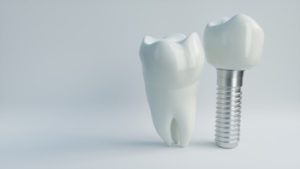July 1, 2022

Dental implants have taken the world of modern dentistry by storm; these awesome little implants have become the premier option for replacing missing teeth. Once placed, they’re able to fully replicate the look, feel, and functionality of your lost pearly whites. But despite their impressive capabilities, did you know they’re still able to fail? And when this happens, your oral health is in jeopardy! Keep reading to learn more from your dentist in Huntington Beach about why dental implants fail and how the issue is addressed.
Why Do Dental Implants Fail?
There are many factors that can cause dental implants to fail, but most failures can be categorized into two types based on when they occur:
- Early failures – These occur within the first few months of the implant being placed, and it usually happens due to the implant still being very loose. This looseness can be caused by things like movement during the healing process, lack of stability, infection, and the overall healing ability of the patient. But since they occur relatively soon after the implant is placed, early failures are typically simple to correct as the implant is often loose enough to easily be removed and replaced.
- Late failures – Late failures occur one year or beyond after the implant placement, and they can sometimes be a little more complicated to deal with. Sometimes an implant starts out just fine and without issue, but loses stability over time due to an infection, excess pressure, or even physical trauma. Other times, the implant can remain sturdy, but X-rays will reveal signs of perio-implantitis, which is a disease that destroys bone matter around the base of the implant—this needs to be handled immediately!
How Are Failed Dental Implants Addressed?
If your dentist has determined that you have a failed implant that needs removal, there are a couple of approaches they can take. One common method involves safely cutting a small, conservative portion of your bone along the edge of the failed implant. This releases some of the built-up tension and makes the implant much easier to remove.
Another common method involves using a special set of tools that utilize reverse torque to remove the implant. If this sounds a little crazy, don’t worry—it isn’t just safe and comfortable, but it’s incredibly effective and eliminates the need for your dentist to remove any bone! In any case, a failed dental implant that is removed must be replaced. Sometimes this can happen immediately afterwards, but other times, a dental bone graft is necessary to create a healthier bone site for the placement of the future implant.
Your dental implants are an important part of you; they allow you to comfortably eat, talk, and laugh your way through life! If you believe one of your dental implants is failing, your situation isn’t hopeless; talk with your dentist to see what your options are for getting your smile back on track.
About the Author
Dr. Justin Braga has proudly served patients and families in the Huntington Beach area for several years. Dr. Braga received his dental doctorate from the University of the Pacific in San Francisco and is a member of many professional organizations including the American Dental Association, the California Dental Association, and the Spears Study Club. His practice is pleased to offer many available services including dental implant salvage. If you have any questions about dental implants or would like to schedule a visit, you can contact Dr. Braga through his website or over the phone: (714) 587-9084.
No Comments
No comments yet.
RSS feed for comments on this post.
Sorry, the comment form is closed at this time.
